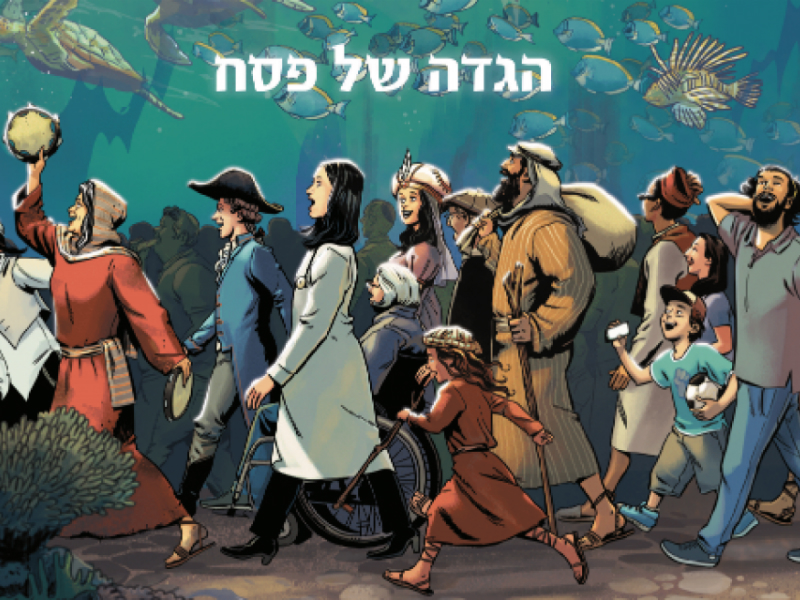Recent surveys in Canada, the United States, and Israel show that between 70 and 90 per cent of Jews attend a Passover seder every year, making it the most well-attended religious event on the Jewish calendar. No wonder so many new haggadot are published every year. Most offer a new commentary and/or change the traditional text, in an attempt to make it more relevant for contemporary celebrants.
The Passover Haggadah Graphic Novel does neither. It provides the standard Hebrew text without deviations and it offers no commentary on the text, at least not in words. It includes detailed stage directions for conducting a seder that conforms to halakhah, a translation of the haggadah into English, and a transliteration of the entire Hebrew text (i.e. Hebrew written in English letters), so that someone who does not read Hebrew can still sing along or recite the Hebrew prayers. (The transliteration is not always well edited: errors include l’ficha instead of l’fichach; tirk’u instead of tirk’du; lay’harim instead of lay’sharim.)
The innovation of this haggadah is in its attractive illustrations which, according to the hype on the back cover, “recast the Pesach festival as contemporary, cool and fun.” The stage directions are speech bubbles coming from the mouths of black and white cartoon characters. The English translation of the haggadah is presented alongside the Hebrew text in the form of an impressively illustrated full-colour graphic novel or comic book.
The translation, by David Olivestone, is both readable and accurate, and it takes only minor liberties with the text. The “four sons” of the haggadah become “the four types of children.” The common, “one wise, one wicked, one simple, and one who does not know how to ask,” becomes “one astute, one rebellious, one innocent and one who cannot even put thoughts into words.” The astute and innocent children in this haggadah are daughters; the less desirable roles are assigned to sons.
In fact, many of the illustrations show women in non-traditional settings. For example, in the “Who Knows One” song, the faces of our four foremothers are carved into a mountain reminiscent of the four U.S. presidents carved into Mt. Rushmore. In the final song of the seder, Chad Gadya, the shochet (butcher) is a woman.
At times, figuring out the connection between the illustrations and the text is a challenge. Why is the line “Whatever work they made them do was enforced brutally” illustrated by a picture of a young man in modern dress shoveling snow while another young man wearing a kippah watches? Why is one part of the Hallel, the prayer that praises God, illustrated with various Israeli inventions, including a USB key, a volume of the Jerusalem Talmud, and a game of Rummikub?
Other illustrations offer creative interpretations. For “the more you elaborate on the story of the rescue from Egypt [the more praiseworthy it is],” two of the illustrations are Rabbi Abraham Joshua Heschel marching with Reverend Martin Luther King Jr., and an Israeli soldier supervising while Ethiopian Jews climb into an airplane, presumably to move to Israel.
READ: GRAPHIC NOVEL BRINGS THE PASSOVER HAGGADAH TO LIFE
For “[If the Holy One, may He be blessed, had not rescued our ancestors from Egypt, our children and] our grandchildren would still be enslaved to the Egyptian Pharaoh,” the translation is superimposed on a crowded open-concept office filled with security cameras, where dozens of Jews in modern dress are working at computers, supervised by frowning taskmasters in traditional Egyptian garb. The haggadah thus subtly suggests ways to make discussions at a contemporary seder relevant to current events or recent history.
Including contemporary illustrations in a haggadah is not new. A few years ago, I reviewed in these pages the
Canadian haggadah, which featured photographs that, if not exactly contemporary, were from the recent past. Arthur Szyk’s famous hagaddah from the 1930s included illustrations with subtle allusions to the rise of Nazism and its dangers.
The Nazis play an even greater role in this 21st century hagaddah. Two examples: the verse from Genesis quoted in the hagaddah, “[Your descendants will have to live in a foreign country] whose people will enslave and oppress them for four hundred years” is accompanied by a picture of Jews working in a Nazi concentration camp. The next phrase from Genesis quoted in the haggadah, “But I will pass judgment on that country,” is illustrated with a picture of Adolf Eichmann’s trial.
Several haggadot since Szyk’s time include references to Nazi Germany. I know that our family seder often discusses parallels between these two stories. But it’s interesting that the traditional Hebrew haggadah takes a completely different tack. Even though most of the traditional text comes from the first centuries of the Common Era, a time of Jewish powerlessness and persecution, it says nothing about the hardships of its own time, including the destruction of the Temple and the brutal Roman occupation of the land of Israel.
Aside from the one famous reference that was added centuries later—that anti-Semitism exists in all generations, but God always saves us—the traditional Hebrew haggadah text concentrates on celebrating freedom and praising God for providing it.
Now in the 21st century, when Jews have unprecedented freedoms, it is ironic that haggadot like the Graphic Novel Passover Haggadah make modern anti-Semitism a central theme in an evening traditionally dedicated to celebrating and thanking God for our freedom.
